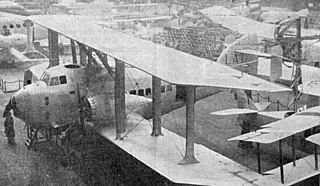
The Fokker F.V was a Dutch airliner created by Fokker in the 1920s. The most interesting property of the F.V was that it could be configured either as a biplane or a monoplane, as the lower wing could be removed. It was not a success and only one was built.

The Avro Andover was a 1920s British military transport aircraft built by Avro for the Royal Air Force. Four aircraft were built, in two versions. Three aircraft, the Type 561, were used as flying ambulances. The sole example of the Type 563 was used as a 12-seater transport.

The de Havilland DH.18 was a single-engined British biplane transport aircraft of the 1920s built by de Havilland.

The Blériot 127 was a monoplane bomber aircraft developed and produced by the French aircraft manufacturer Blériot.
The Farman F.120 were a family of multi-engine monoplane aircraft designed and produced by the French aircraft manufacturer Farman Aviation Works. It was operated in a diverse range of purposes, including as a commercial airliner and as a military bomber aircraft.

The Farman F.170 Jabiru was a single-engine sesquiplane airliner designed and built by the French aircraft company Farman Aviation Works. It is a derivative of the F.121 Jabiru.

The Farman F.50 was a French twin-engined night bomber designed and built by Farman as a replacement for the single-engined Voisin pusher biplanes in service with the French Air Force.

The Farman F.70 was a 1920s French passenger and mail transport aircraft designed and built by the Farman Aviation Works. It was a smaller counterpart to the company's popular F.60 Goliath. The F.70 was an unequal-span two-bay biplane with a wooden fuselage and was powered by a Renault 12Fe piston engine. The pilot was seated in an open cockpit behind the nose-mounted engine. Behind the open cockpit was a cabin for four passengers or freight.

The Farman F.300 and F.310 were trimotor monoplane airliners designed and produced by the French aircraft manufacturer Farman Aviation Works.

The PWS-20 was a Polish single-engine high-wing 8 passenger airliner, built in the PWS factory and when it made its first flight in 1929 it became the first Polish-designed transport aircraft to fly.

The Hanriot H.43 was a military utility biplane designed and produced by the French aircraft manufacturer Hanriot. It was primarily used by the Aéronautique Militaire as a trainer aircraft during the interwar period.
The Nieuport-Delage NiD 640 was a four-passenger transport monoplane designed and produced by the French aircraft manufacturer Nieuport-Delage.

The Latécoère 4 was a three-engined, 15-passenger biplane built in France in the early 1920s. It proved difficult to fly and was discontinued, though a second machine was completed as the Latécoère 5 bomber.
The Farman F.250 was a small, four passenger single engine low cantilever wing airliner built in France in 1931. The single example built was bought by an airline but was little used, owing to stability issues.

The Farman FF 65 Sport was a French built light biplane, with a single engine and tandem seats, intended for sport and touring. First flown in 1919, it achieved modest sales at home and abroad in the early 1920s. Two unusual modifications produced a biplane glider and a low aspect ratio parasol wing machine.

The Farman F.90 was a single engine biplane transport, carrying 6 passengers. It was built and developed in France in the early 1920s. Though it had some competition successes, it was not put into production

The Farman F.140 Super Goliath was a very large, four engine biplane night bomber, designed in France in the mid-1920s. Nine flew with the French Air Force until concerns about structural weakness grounded them in 1930. The prototype set several world records for altitude reached with heavy useful loads.

The Timm T-840 was a twin engine, high wing passenger aircraft designed and flown in the United States in 1938. Equipped with a tricycle undercarriage and low speed aerodynamic devices, it could be configured to carry between six and ten passengers. Only one was built.

The Caudron C.39 was a French three-engined biplane with a cabin for six passengers when the aircraft was equipped as a landplane or four passengers when on floats. It was flown with some success in competitions in 1920 and 1921.
The Simplex Red Arrow was a US single-engined monoplane produced in the late 1920s and early 1930s and intended as club machine or mail transport. Most used radial engines in the 90–110 hp (67–82 kW) range. They carried one or two passengers whose seats could be open or enclosed. One variant, the Red Arrow Dual Plane, was easily converted from monoplane to biplane and was available with two versions of the much more powerful Wright Whirlwind engines. In all about 20 were built.


















